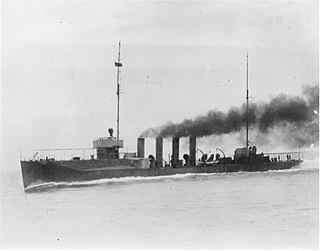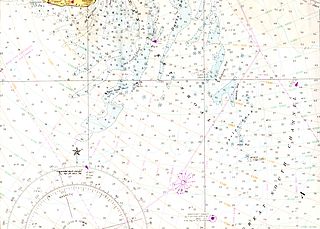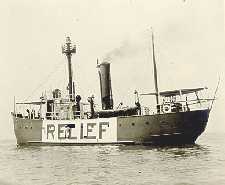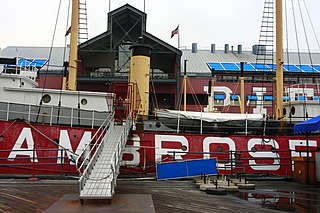Related Research Articles

A lightvessel, or lightship, is a ship that acts as a lighthouse. They are used in waters that are too deep or otherwise unsuitable for lighthouse construction. Although some records exist of fire beacons being placed on ships in Roman times, the first modern lightvessel was off the Nore sandbank at the mouth of the River Thames in London, England, placed there by its inventor Robert Hamblin in 1734. The type has become largely obsolete; lighthouses replaced some stations as the construction techniques for lighthouses advanced, while large, automated buoys replaced others.

United States lightship Chesapeake (LS-116/WAL-538/WLV-538) is a museum ship owned by the National Park Service and on a 25-year loan to Baltimore City, and is operated by Historic Ships in Baltimore Museum in Baltimore, Maryland. A National Historic Landmark, she is one of a small number of preserved lightships. Since 1820, several lightships have served at the Chesapeake lightship station and have been called Chesapeake. Lightships were initially lettered in the early 1800s, but then numbered as they were often moved from one light station to another. The name painted on the side of lightships was the short name of the Light Station they were assigned to and was the daytime visual aspect of the many Aids to Navigation on board lightships. The United States Coast Guard assigned new hull numbers to all lightships still in service in April 1950. After that date, Light Ship 116 was then known by the new Coast Guard Hull number: WAL-538. In January 1965 the Coast Guard further modified all lightship hull designations from WAL to WLV, so Chesapeake became WLV-538.

The O'Brien class of destroyers was a class of six ships designed by and built for the United States Navy shortly before the United States entered World War I. The O'Brien class was the third of five classes of destroyers that were known as the "thousand tonners", because they were the first U.S. destroyers over 1,000 long tons (1,016 t) displacement.

The station named Nantucket or Nantucket Shoals was served by a number of lightvessels that marked the hazardous Nantucket Shoals south of Nantucket Island. The vessels, given numbers as their "name," had the station name painted on their hulls when assigned to the station. Several ships have been assigned to the Nantucket Shoals lightship station and have been called Nantucket. It was common for a lightship to be reassigned and then have the new station name painted on the hull. The Nantucket station was a significant US lightship station for transatlantic voyages. Established in 1854, the station marked the limits of the dangerous Nantucket Shoals. She was the last lightship seen by vessels departing the United States, as well as the first beacon seen on approach. The position was 40 miles (64 km) southeast of Nantucket Island, the farthest lightship in North America, and experienced clockwise rotary tidal currents.

The United States lightship Huron (LV-103) is a lightvessel that was launched in 1920. She is now a museum ship moored in Pine Grove Park, Port Huron, St. Clair County, Michigan.

United States lightship Columbia (WLV-604) is a lightship located in Astoria, Oregon, United States of America. Columbia was formerly moored near the mouth of the Columbia River.

Lightship Ambrose was the name given to multiple lightships that served as the sentinel beacon marking Ambrose Channel, New York Harbor's main shipping channel.

United States Lightship 101, now known as Portsmouth as a museum ship, was first stationed at Cape Charles, Virginia. Today she is at the Portsmouth Naval Shipyard Museum in Portsmouth, Virginia. Portsmouth never had a lightship station; however, when the vessel was dry docked there as a museum, she took on the pseudonym Portsmouth. A National Historic Landmark, she is one of a small number of surviving lightships.

United States lightship Nantucket (LV-112) is a National Historic Landmark lightship that served at the Lightship Nantucket position. She was the last serving lightship and at time of its application as a landmark, one of only two capable of moving under their own power. She served as the lightship for such notable vessels as the liners United States, Queen Mary, and Normandie.

USS Goldfinch (AMS-12/YMS-306) was a YMS-1-class minesweeper of the YMS-135 subclass acquired by the U.S. Navy for the dangerous task of removing mines from minefields laid in the water to prevent ships from passing.

United States lightship Relief (WLV-605) is a lightvessel now serving as a museum ship in Oakland, California. Built in 1950, she is one of a small number of surviving lightships, and one of an even smaller number built specifically for the United States Coast Guard. Along with her sister ship, the WLV-604 Columbia, she is a good example of the last generation of lightships built. She was declared a National Historic Landmark in 1989.

Lightship No. 114, later U.S. Coast Guard WAL 536, that served as lightship Fire Island (NY), Examination Vessel, Diamond Shoal (NC), 1st District relief vessel, Pollock Rip (MA) and Portland (ME). After decommissioning in 1971, in 1975 the lightship became a historic ship at the State Pier in New Bedford, Massachusetts. She received little maintenance, and eventually sank at her moorings in 2006 and was sold for scrap the next year.

The Shearwater is an 81.5-foot (24.8 m) wooden schooner docked in Lower Manhattan in New York City in the U.S. state of New York. The schooner was designed by Theodore Donald Wells and built by the Rice Brothers Corporation in East Boothbay, Maine in 1929. During World War II, it was requisitioned into the United States Coast Guard to patrol for German U-boats. The Shearwater completed a circumnavigation of the world in the early-1980s and later worked as a research laboratory for the University of Pennsylvania's Institute of Environmental Medicine. Docked about 200 yards (180 m) west of the site of the World Trade Center, it is operated by Manhattan by Sail, which gives 90-minute-long tours of New York Harbor, and is licensed to carry 48 passengers. The schooner was listed on the National Register of Historic Places in 2009.

YP-26 was a former U.S. Coast Guard wooden patrol boat which saw later duty with the U.S. Navy until destroyed in a 1942 accident.

Hodgdon Yachts is a builder of yachts and specialized military vessels, based in East Boothbay, Maine. It is a family-run business that was founded in 1816—the oldest continuously operating family boatbuilder in the United States, antedating the Burger Boat Company in Wisconsin. Hodgdon Yachts is noted for building superyachts, both sail and power, using advanced composite materials and construction techniques. It's also noted for its ability to incorporate those advanced materials into traditional designs that employ modern electronic and mechanical marine systems. The company has several divisions—yachts, custom tenders, yacht interiors, yacht services and military composites with offices in Boothbay, Maine, Newport, Rhode Island and Monaco.

The United States Coast Guard wooden-hulled 75-foot patrol boats were built during Prohibition to help interdict alcohol smugglers. Their nickname was derived from the slang term "six bits" meaning 75 U.S. cents.

USS YP-19 was a wooden-hulled patrol vessel in commission in the fleet of the United States Coast Guard as CG-177 from 1925 to 1934, and in the fleet of the United States Navy as YP-19 from 1934 until 1945.

Al Larson Boat Shop or Al Larson Boat Building is a shipbuilding and dry dock repair company in San Pedro, California on Terminal Island. To support the World War 2 demand for ships Al Larson Boat Shop built: US Navy Sub chasers and Minesweepers. Al Larson Boat Shop was started in 1903 by Peter Adolph (Al) Larson, a Swedish immigrant. Larson started by building boats by hand from Pacific Northwest lumber. As the shop grew, he moved to its current location in Fish Harbor, in the Port of Los Angeles. Adolph Larson's son sold the boat shop in 1960 to Andy and Gloria Wall. The shop was small at this time with only five employees. The Wall family is still running the shipyard in the Port of Los Angeles. The shipyard is the only one in the Port of Los Angeles now operating and able to work on ships of all sizes with its 100 employees. The shipyard is at 1046 South Seaside Ave, Terminal Island, with 2.35 acres of land and 5.35 acres of waterways. The shipyard also runs a marina, Al Larson Marina.
New York Yacht, Launch & Engine Company was a shipyard located on the Harlem River in the Morris Heights neighborhood of the Bronx.
References
- 1 2 3 4 5 6 Colton, Tim (July 28, 2016). "Rice Brothers - East Boothbay, Maine". shipbuildinghistory.com.
- ↑ Flynn, James T. Jr. (23 June 2014), "Birth of the Six Bitters - The Start of Prohibition Enforcement Afloat in Earnest" (PDF), U. S. Coast Guard Small Cutters and Patrol Boats 1915 – 2012: Vessel of less than 100-feet in Length, U.S. Department of Defense, pp. 3–13
- 1 2 3 Moody, Roger. "Rice Brothers' Legacy of Lightships". maineboats.com.